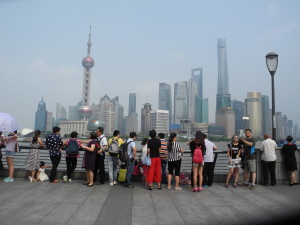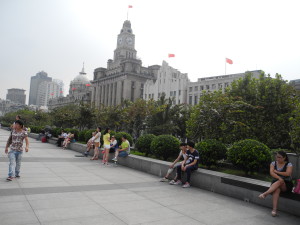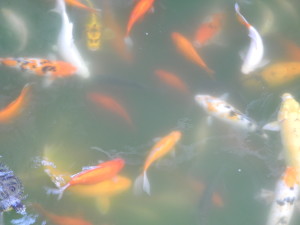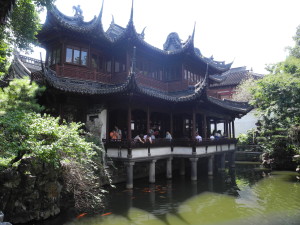
Selfie, anyone? Walkway along the Huangpu River, with Pudong in background. Photo by Catharine Norton.
Second in a Series:
I suppose the title “City of the Past, Present and Future” could apply to many cities — but few, if any, as much as Shanghai, China.
Within the course of a few blocks — or just across the street in some cases — you can go from narrow alleyways lined with shacks that have no kitchens or indoor plumbing, to magnificent old temple and garden complexes, to stately colonial-era houses sequestered behind shady sycamore-lined streets, to a pedestrian walkway lined with super-modern clothing and electronics stores that light up like Times Square at night, to a waterfront lined with more colonial-era buildings and a river walk that has to be the selfie-taking capital of the world.
And across the river (providing a background for the selfies) lies the region known as Pudong, which has mostly sprung up in the past 20 years and features futuristic architecture, one of the world’s tallest skyscrapers, and row upon row of high-rise apartment complexes that help shelter some of the city’s 24 million residents.
Yes, that’s right — 24 million: and it isn’t even China’s largest city.
My wife, Catharine, and I spent three days in Shanghai recently and barely scratched the surface of all there is to do and see, but we saw enough to know that Shanghai is on the cutting edge of world cities, even as some of its residents still live in squalor. But judging by the crowds filling the Apple store — buying the phones and iPads and other devices used for all those selfies — the percentage of Shanghai residents with money to spend is rising as rapidly as some of those giant apartment buildings that extend from Pudong to miles outside the city.
When we arrived one morning on a flight from Beijing, we decided to take the subway in from the new airport in Pudong to center city. Despite Shanghai’s fast and efficient subway, it proved a lengthy trip — both because the airport is a long way from the center and because, being new in town, we didn’t realize our train would start heading back in the opposite direction before we reached our destination. Why that was, we don’t know — my maxim is: never try to figure out why the Chinese do anything.
A Chinese man tried to convince us to get off, but it was too late. In any event, had we known, we could have taken the mag lev — magnetic levitation — train in from the airport. The world’s first magnetic levitation train travels up to 250 mph and costs about US $7, depending on ticket type, which is about seven times the cost of a subway ticket, but it gets to the main area of Pudong in about eight minutes. (From there we would have had to catch a subway or taxi to central city, but the whoosh would have been worth it.)
Some say that the Chinese built the mag lev for no good reason other than that they could, but it beats fighting traffic or going the wrong way on the subway.
Actually, we came to love the subway once we discovered the joys of the multi-day pass (no trying to decipher the ticket machines while dozens of impatient Chinese wait and murmur — or swear — behind you) and learned the signal (the lights dimming twice in the car) that your train is about to head backwards.
Our hotel — called the Seventh Heaven because the lobby is on the seventh floor — had a wonderful location right on East Nanjing Road, which had been turned into the pedestrian walkway I mentioned earlier, and which was lined with not just super-modern, high-end stores but cafes where you could get a coffee, a beer or a snack, and an entire four-story building called the Foodmall that was, predictably, devoted to food, where we proceeded to eat happily.
We spent much of our time in Shanghai strolling along the Bund — lined with magnificent old colonial-era buildings that now were overshadowed by bizarre-looking skyscrapers to their rear — and along the river walk across the street from the Bund. On the day we arrived, which was some kind of Chinese holiday as it turned out, we were accompanied by approximately half the population of Shanghai, all of whom were snapping pictures of each other with their smartphones, taking selfies, or both.
The Shanghai emergency rooms must be filled with folks who have suffered various injuries from passing too close to selfie sticks — eyes poked out, elbows gouged, etc. “Selfie doc” might become a new specialty there.
Along the way we discovered a wonderful fresh orange drink with real pulp; I wish I could pass along the name, but it was in Chinese. Watch for the blue label with an orange pictured on it.
We also took the ferry across the Huangpu River to Pudong, which cost two yuan (about 30 cents) and took about five minutes, just about time for the bulk of the passengers to take 50 selfies at a rate of ten per minute.
Pudong also had a nice walkway along the river, and we found a German-style beer garden there with cold beer, a novelty in China despite the heat.
Back in the main part of the city, we discovered the bridge leading over to the Russian embassy, which has a prime location overlooking the river. A bride and groom were having their wedding pictures taken in the middle of the road, rather hurriedly because when the lights down the way turned to green, the cars would come racing across the bridge and — pre-wedded bliss notwithstanding — no doubt proceed to run them down.
Pedestrians definitely do not have the right of way in China, or if they do, the automobile and motorbike drivers have not been so informed. Indeed, motorbikes seem to have carte blanche to run red lights. What happened to all the bicycles that were here on my last visit to Shanghai in 1993? Run down and mangled by motorists, I suspect.
The selfies stopped just long enough to take pictures of the imperiled bride and groom, which was refreshing.
We also enjoyed Yu Yuan Gardens, which was a jewel-like oasis of koi ponds, tea houses, and ancient structures that we would have never found except for a helpful Chinese man on his lunch break, who led us to them. “You haven’t seen Shanghai until you’ve seen Yu Yuan,” he told us. “But these” — he pointed to the ancient-looking structures leading up to and surrounding Yu Yuan — “were all built in the past 20 years, made to look old,” he added.
I admit, I would have been fooled. But I was especially relieved to be able to say I’d seen Shanghai.
And one night we strolled through the old French Concession area, where colonial powers once held sway when Shanghai was an international city, divied up between various Western powers. Stumbling upon a street lined with expat bars, we pulled up two seats at an outdoor table in a Portuguese place and ordered two beers plus octopus, clams, and olives.
It was our only non-Chinese meal of our stay in Shanghai, but the cold beer helped alleviate the guilt. And no one was taking selfies.
Next up: Cruising the Yangtze
Travel Tip of the Day: When traveling overseas, you’ll often get the best exchange rate on local currency by using ATMs rather than hotels or foreign exchange offices. But since ATMs often come with exorbitant fees, it’s best to take out enough cash to make the transaction worthwhile (familiarize yourself with the exchange rate before using the ATM so you know the value of the money you’re taking out). And be sure to notify your credit card issuer that you’ll be traveling abroad, or risk having a hold put on your ATM card when you try to use it.
Readers: You can subscribe to my blog and get notification of every post by simply typing in your email address and clicking on the blue Subscribe button or downloading my free report, How to Ride the Coming Wave of Boomers. Thanks!















Leave a Reply